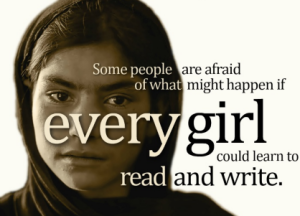A number of developing countries are confronting gender disparities especially in education sector, there are certain aspects which are being neglected and overlooked; [however], education can strongly direct countries to the loom of prosperity. According to the World Bank, there is no investment more effective for achieving development goals than educating girls.
In reports, we bluntly pen down that Pakistan is succeeding in achieving gender balance in school enrollment of boys and girls whereas there is a contradiction. Being enroll is another aspect of

gender disproportion because there is (more often than not) absence of girls’ schools in villages of Pakistan. This disparity has decreased to a considerable extent in the Urban districts where as, the problem continues to prevail in the Rural districts where parents and head of the households fail to acknowledge the importance of female education. While being travelling around Punjab I have witnessed this lack of correspondence and infrastructures.
According to the UNESCO, “Pakistan has been experiencing immense gender disparity in the education sector over the years. Pakistan has not acquired hold of any of the Education for All goals with measurable targets, however made noteworthy evolution in purging the gender gaps, predominantly in the early years after 2000. When the goals were brought into the light, there were 68 girls enrolled for 100 boys. By 2007, there were 83 girls although this only increased to 87 by 2012.”
There are various factors which dampen parents to educate their daughters; these factors are awfully strong in the rural districts.
Cultural norms: Due to the cultural norms prevailing in Pakistan, most of the people expect women to look after the house and be adept in household chores. Therefore, parents pay no or little attention to a girl’s education believing that it would be useless for her in the future.
Stereotypes: Stereotypes prevailing in the society are a strong barrier to female education. It is considered that a very educated female is too clever or thinks she is too superior to be confined to do household chores. Moreover, working females are still considered a taboo in some societies. Furthermore, parents believe that if they educate their daughters too much so they would not be able to find suitable grooms for themselves.
Wealth: Income of the family is a crucial factor hindering education of females. It has been observed that high income families pay more attention to female education than low-income families. Low income families pay more attention educating boys of the family since they believe that their son would help them look after the family business or earn for them in future. Whereas, they consider spending money on a girl’s education as a lost investment thinking that their daughter would soon go to her husband’s place and would give no benefit to them in the future.
Age: Many parents, especially in the rural districts, marry their daughters at a very early age which leaves them uneducated for the rest of their lives. Moreover, parents do not educate their daughters when she grows up feeling it inadvisable for them to go out of the house unnecessarily.
Religion: Many parents restrict the movement of their daughters out of the house in the name of religion. This is frequently common in the rural districts, where parents do not allow their daughters to walk out freely from their house after a certain age. They are of the view that a female should not have any sort of encounter with males as it is strictly forbidden in the religion. Furthermore, parents do not allow their daughters to study in co-education schools because they believe it is prohibited in the religion. But it’s a Myth actually.
Household factors: It is believed by many that husbands should always be more educated than their wives. This statement is religiously followed in rural areas and to a great extent in the urban districts. Furthermore, the generalized perception is that husbands should be the primary source of earning for the family, and many parents sought to marry their daughters to families where they would not have to work. This view discourages parents from educating their daughters.
Transportation: Unavailability of suitable female transport is a problem faced by many females living in the rural districts. There are hardly any colleges near the houses. They are located miles away from the house so parents do not feel comfortable with sending their daughters so far from the house especially when there is no transportation.
Government reforms: Government does not seem to take adequate measures or reforms to eliminate gender disparity in education. There are hardly any incentives given to the parents so they’d want to educate their daughters.
References:

Recent Comments